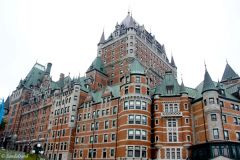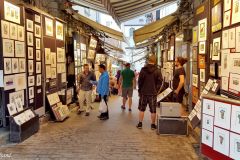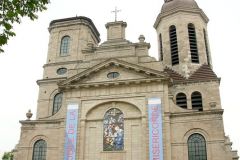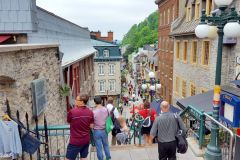There’s an almost royal view of the mighty Saint Lawrence when you stand on the terrace in front of the Chateau Frontenac, in Quebec City. The lower town, the upper town, the citadel, they all make up wonderful places to stroll and relax in.
A short history
This 400 years old city is very European, by architecture, history and language. The First Nations as they are called in Canada, came here first of course. The first European settlement was in 1535 when explorer Jacques Cartier built a fort. During the rest of the century there was so much hostility with the natives, and an inhospitable winter climate, that the city was not formally founded until 1608, with Samuel de Champlain as the champion. Quebec city has a strategic location on a narrow point on the Saint Lawrence River, just before the river ends in the Gulf of Saint Lawrence, with the world’s largest estuary. The almost constant wars between the British and French during these early centuries ended with a final British takeover in 1763.
It was, and the Old Town still is, thoroughly French. The stone buildings, including magnificent hotels, churches and government buildings, cobblestone streets, bistrots and side-walk cafes, the oldest intact fortress north of Mexico, and the magnificent location on the Saint Lawrence River has earned Old Quebec a place on the UNESCO World Heritage List. The French language is the most spoken language in Quebec City with 95% of the population holding it as their mother tongue, although one third is bilingual. The flag of the province of Quebec draws heavily on French symbols: A white cross on a blue background (symbolising Heaven) and four white fleurs-de-lis (for purity) in the quadrants.

Restaurants, small shops in stone houses. This is the Quebec we like to discover.
What to see
I had 24 hours at my disposal, not much. Still, many of the sights interesting for a first-time visitor are within walking distance. Quebec City has about 500,000 inhabitants and 300,000 more around.
The compact, oldest part is divided between the Old Upper Town (Haute Ville) as it is called and the Old Lower Town (Basse Ville) where Champlain first established himself in 1608. The two are connected by a funicular, steps and steep roads. These parts are extremely picturesque – and tourist packed. The huge Chateau Frontenac is a spectacular hotel and holds a dominant position in the Haute Ville.
My walks brought me along the walls of the Citadelle, built by the British in 1820 and onto the top of the fortress. This part of the city has parks (like the large Plains of Abraham) and even more prominent public buildings, like the Hotel du Parlement.
All these sights are better explained in other resources, so let me just finish by presenting my map. It is expandable into a new tab or window, and also to be worked in by zooming and clicking. I spent some time before going and while in Quebec, compiling these points of interest. My suggestion is to zoom in on Quebec city to discover my findings, most of which I actually made it to.
Read more
Learn more about what to see by heading to the Quebec region tourism authority and the municipal website. There are also guidebooks, like Lonely Planet.
This article is part of a series based on a four-night visit to three major cities in eastern Canada.
(1) Montreal
(2) Quebec City (THIS)
(3) Ottawa
WHC List #0300 – Historic District of Old Québec
Finally, here are some miniature pictures to click and browse in larger versions.





































